Separation Anxiety

Greyhounds have an upbringing unlike any other dogs'. While most dogs are taken from their mothers and littermates at 8 or 10 weeks old or even earlier, greyhounds usually stay with their littermates for the first year of their lives and sometimes their mothers too. At around one year of age the litter goes together to race training. At around 15 months they are moved to racetracks. Ones with similar racing skill may be moved to the same track, but at this point they may be split up. The better racers are sent to better tracks and the ones that don't show as much promise are sent to lower end tracks or are retired without racing. At the farm, in training and at the racing kennel they are always around a large number of other greyhounds. When they retire and come to us they are even in a foster home with other greyhounds. The first time your dog has ever been alone in its life may be the first time you leave him. Understandably separation anxiety is one of the most common behavior problems we see in greyhounds.
When you bring a new greyhound into your home many things have just happened in his life that are anxiety triggers:
- Novelty - everything is new to him - new household items, new people, new animals, and first time in a house.
- Invasion of personal space - disruption when resting, hugging, kissing, forcibly restraining. We know you want to love your new dog but give him space to avoid stressing him out.
- Changes in housing - moving to a new foster home, then a new adoptive home.
- Changes in household members - new foster family, adoptive family and possibly kids and new pets in the household to adjust to.
- Separation from human family and dog family members - loosing his trainer and his littermates, losing foster family, and losing you when you leave for work.
- Changes in routine - new feeding schedule, new potty break schedule, new house rules and often more time out of the crate than he is comfortable with.
- Lack of outlets for normal breed behaviors- after training and racing for months, if not years, he is suddenly retired and no longer allowed to do what he was bred for and loves more than anything - chase a lure. No matter your personal opinion of racing, your greyhound loved to chase a lure more than he will ever love laying on your couch and more than he will love you. They will choose to chase a lure over food, drink, sleep or even the opposite sex. This is the reason greyhounds can not be trusted off leash outside a fenced area. No matter how much your greyhound grows to love you, he will choose the chase over you and will not come back when you call. If your greyhound retired healthy you may consider taking him to a greyhound playgroup or to a lure coursing or for fun race meet so he can still chase a lure. There is no mistaking how much they love it.
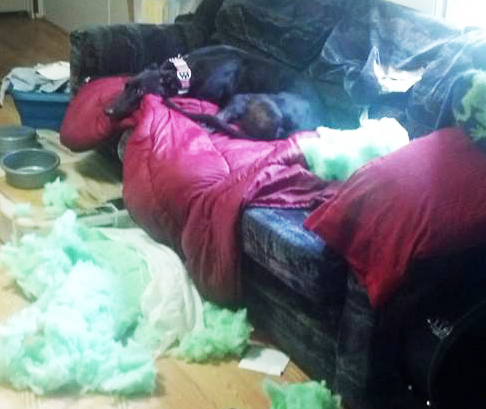
Here are some things that we found that help:
Use your crate! Most greyhounds will be more comfortable in a crate than loose in your house. It will keep them safe and keep your house safe from an anxious dog. The best crate to use with an anxious dog is an airline approved plastic vari kennel. These are pretty escape proof, which is why they are used on airlines. Many dogs with SA (Separation Anxiety) stress in or out of the crate and may try to chew or push their way out of a metal crate. If you already have a metal crate, you want to use, you can reinforce the crate with metal clips (the type on leashes) all around the top, sides and door of the crate to make it escape proof.
Your greyhound has lived in a crate for months, if not years, at the track. Having something familiar to him, like a crate, to stay in, is a great transition from kennel to home life. The crate is something familiar that he knows and understands, in a world of scary new unfamiliar things. Most greyhounds have never been in a home before they come into our foster program. They can be totally overwhelmed, if they are just turned loose in an unfamiliar house and expected to fend for themselves, when you leave. Dogs with separation anxiety have gone through walls, windows, and injured themselves, so leaving the dog loose just isn’t safe for the dog or your house.
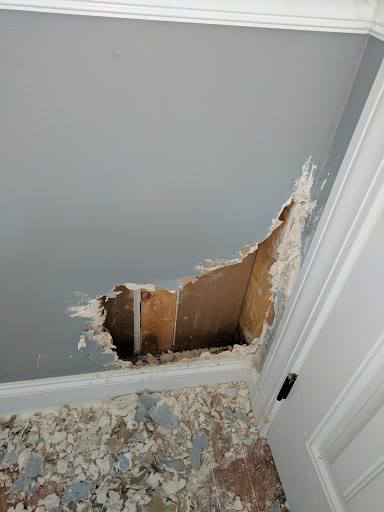
Increasing exercise is the key with most behavior problems. A sleeping, exhausted greyhound doesn't stress, make noise or do bad things. Fortunately greyhounds are pretty easy to wear out. If you can get your greyhound really tired, before you leave, he will probably just sleep while you are gone. Exercise helps in another way because it releases chemicals in the brain that actually make the dog and humans feel happier and less stressed. This is probably the MOST important thing to do with a new dog, to prevent separation anxiety from ever starting, and to stop separation anxiety once it has started.
Feed your greyhound all his meals and treats in his crate to help him continue looking at the crate as a good place.
Play soothing music or turn on a TV in the room the dog is in. They do this at the track and it helps the dogs stay calm.
Crate your greyhound some when you are home too so that he doesn't associate the crate with being left. Crating him some while you are home also helps him realize that he doesn't HAVE to be with you every second of the day. If you use the crate when you are home you can correct digging at the crate, chewing at the crate, trying to get out, or vocalization and encourage your greyhound to rest in the crate calmly. Train your greyhound to wait to be fed in the kennel with the door open. This teaches valuable self control.
When you leave, put him in his crate 10 or 15 minutes before you actually go out the door. That gives him a chance to settle in the crate before you go and helps keep him from associating the crate with you walking out the door. When you come home, wait until he is calm to let him out.
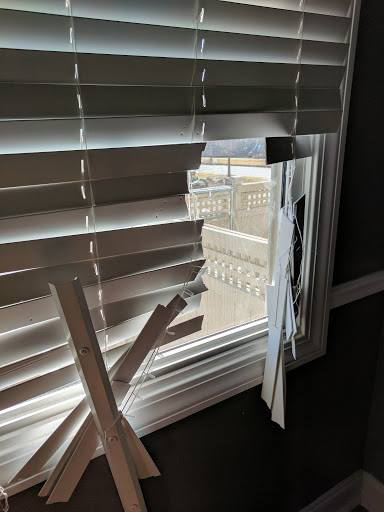
Be sure not to accidentally reward behavior you don't want by talking to your dog (other than correcting him) when he whines or barks. Don't look at him or give him any love or affection when he is whining, barking or acting stressed or excited. Don't ever let him out of his crate when he is excited or making noise.
Reward Calm! Wait until he is totally calm, after you come home, to let him out. You want to only reward calm behavior. Your arrival home SHOULD NOT be the most exciting time of the day for him. If your dog appears anxious, no touching, talking to him, or petting him. That tends to reward the behavior rather than calm them down. Any reward causes the stress to get worse rather than better. Either ignore any behavior you don't want, or correct it and that includes anxious behaviors.
Stay calm yourself! Be sure not to worry about your dog because he will pick up on your worry and stress even more. The calmer and more laid back you are around him, the calmer he will be. Know that this is not something your dog is doing to "get even" with you for leaving him. He is not being "spiteful". This is fear and anxiousness that is so extreme that it causes them to panic, loose control of their bowels and even sometimes injure themselves in an attempt to get to their pack.
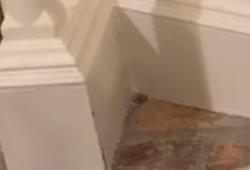
Teach him commands - specifically "down" or "bed" and "stay". Teach him to lay on his bed rather than following you from room to room when you are home. This teaches the dog self control and how to be away from you. Lack of self control is one of the problems with dogs that have separation anxiety. This is something that takes work and time.
Watch the tone of your voice too - high pitched squealing when you come home creates excitement and you don't want your greyhound to associate your leaving or coming home with excitement. Even though it is fun to be greeted like a rock star, it isn't good for a dog with SA.
Use their nose - Dogs are very nose oriented and some people have had good luck with essential oils like lavendar. Just scenting the bedding with it. Rescue Remedy is a combination of scents that help some dogs too. Then there is the DAP diffuser available in pet stores that has Dog Appeasing Pheromones in it. Sometimes putting an article of your clothing in the kennel with them helps.
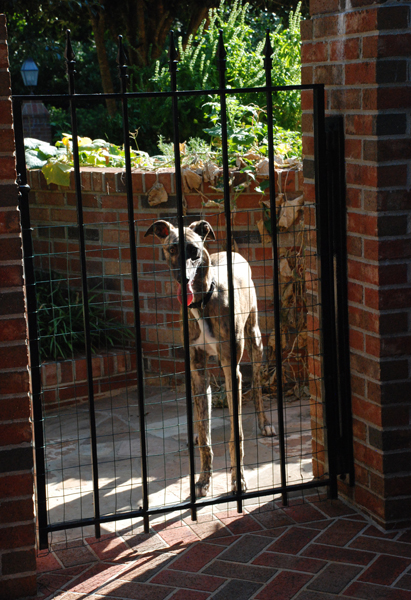
Keep him busy - Use a Kong toy filled with peanut butter or treats- freeze it to make it last longer. Try bully sticks, bones or chew toys. Remember to cut back on his usual meals or all the extra treats can lead to a fat dog.
Do not leave your greyhound outside to prevent damage to your house. A dog with extreme separation anxiety is likely to jump over, climb or dig under a fence. Greyhounds are very heat and cold intolerant so will be much more comfortable indoors in a crate.
Consider getting another dog. A good way to find out if this will help your dog, is to offer to foster another greyhound. If you have another dog already, be sure to keep it in the room with the greyhound, within view, by shutting doors or using a baby gate.
Consider medication- having a medicated dog is not what most of us want, but with SA the dog is so stressed that it can't help acting out. He isn't doing it because he is mad at you, he really is miserable and afraid. Medication can take the edge off, so he can control himself and can learn to be comfortable alone. It usually isn't a permanent thing. Once the dog has learned how to relax when alone, most can be gradually weaned off the medication. Please talk to your vet if the methods above fail. Medication is a kinder solution than rehoming the dog. This type of dog loves you deeply and rehoming him will only fix the problem for you, while making his worst fear a reality.
Exercise is the key though. Tired dogs don't stress or act out. Exercise releases chemicals in the brain that relieve stress often as well as a medication. Do not skip the exercise!!!
We like this article from Dr Karen Becker on Anxiety

Previous page: Helping Your Greyhound With Firework and Thunderstorm Phobia
Next page: Kids & Greyhounds